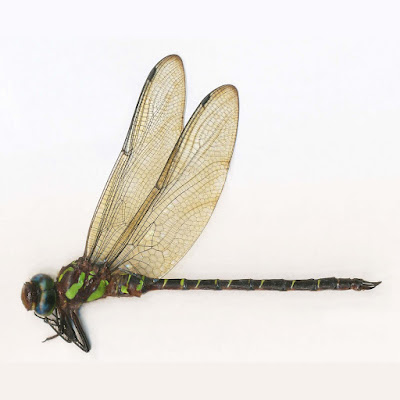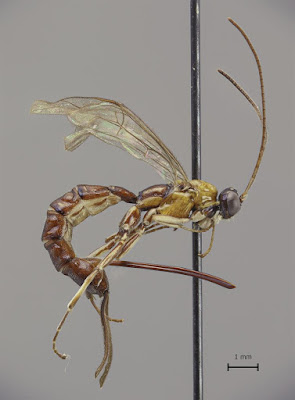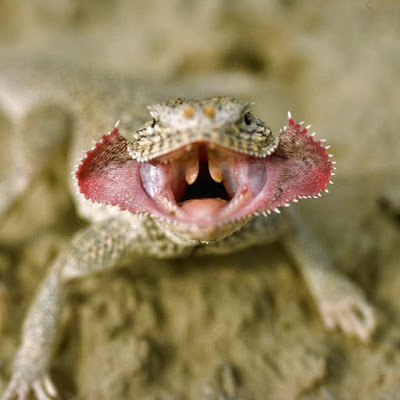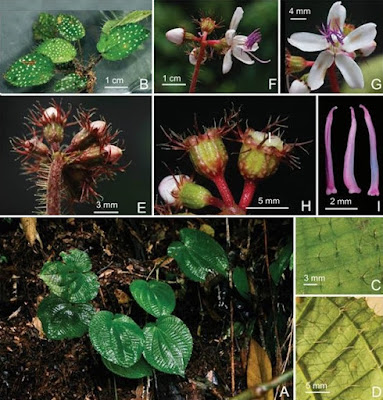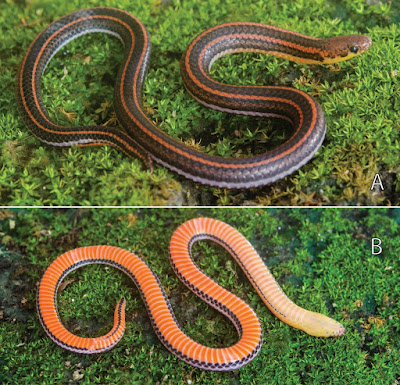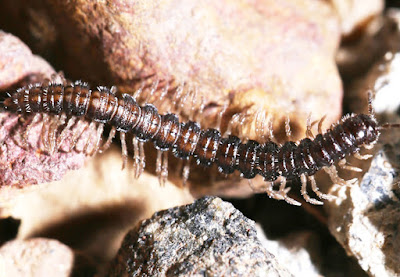[Most Recent Entries] [Calendar View]
Wednesday, September 5th, 2018
| Time | Event | ||||
| 2:53a | [Entomology • 2018] Cephalaeschna yanagisawai • A New Species of Cephalaeschna (Odonata: Anisoptera: Aeshnidae) from northern Vietnam
Abstract A new aeshnid species, Cephalaeschna yanagisawai sp. nov. from northern Vietnam (Hoang Lien National Park, Lai Chau Province, ..., 1900~2000 m a.l.s.), is described and illustrated. This species can be differentiated from the other species of the genus by body maculation, the morphology of the male anal appendages, and female postero-ventral S10 tergite projecting posteriorly, which is a rare feature in the genus. Keywords: Odonata, Cephalaeschna yanagisawai, Hoang Lien, Lai Chau Province Akihiko Sasamoto and Van Vu Lien. 2018. Description of A New Species of Cephalaeschna (Odonata: Anisoptera: Aeshnidae) from northern Vietnam. Zootaxa. 4471(2); 334–340. DOI: 10.11646/zootaxa.4471.2.5 | ||||
| 9:44a | [Entomology • 2018] The Neotropical Species of Clistopyga (Hymenoptera, Ichneumonidae, Pimplinae). Part II: the Clistopyga isayae species group, with the Description of Seven New Species Abstract The New World Clistopyga isayae species group is revised. Seven species are described as new: Clistopyga crassicaudata sp. nov., C. isayae sp. nov., C. kalima sp. nov., C. nigriventris sp. nov., C. panchei sp. nov., C. splendida sp. nov. and C. taironae sp. nov. An illustrated identification key to all species of the group is provided. The Clistopyga isayae species group is composed entirely of previously undescribed species mainly from Andean forests of tropical South America. Keywords: Hymenoptera, South America, taxonomy, parasitoid wasps, new species, key, Amazonia, Andes, spiders Clistopyga crassicaudata Sääksjärvi, Bordera & Palacio sp. nov. Etymology. The specific name refers to the distinctly thickened ovipositor apex. Clistopyga isayae Díaz, Bordera & Palacio sp. nov. Etymology. This species is named in honor of Mérida Isaya, wife of Francisco Díaz, coauthor of this paper. Clistopyga kalima Palacio sp. nov. Etymology. This species is named in honour of the Precolombine indigenous tribe of Kalimas, who lived in the territory that today is the type locality, Valle del Cauca (Colombia). Clistopyga nigriventris Palacio sp. nov. Etymology. The specific name refers to the entirely black tergites of metasoma that distinguish this species from all the other members of the isayae species-group. Clistopyga panchei Palacio sp. nov. Etymology. This species is named in honor of the Precolombine indigenous tribe of Panches, who lived in the territory that today is the type locality, Cundinamarca (Colombia). Clistopyga splendida Palacio & Bordera sp. nov. Etymology. The specific name refers to the beautiful colour patterns of this species. Clistopyga taironae Palacio, Bordera & Díaz sp. nov. Etymology. This species is named in honour of the Precolombine indigenous tribe of Taironas, who lived in the territory that today is the type locality, the Sierra Nevada de Santa Marta, Magdalena (Colombia). Edgard Palacio, Santiago Bordera, Ilari E. Sääksjärvi and Francisco Díaz. 2018. The Neotropical Species of Clistopyga (Hymenoptera, Ichneumonidae, Pimplinae). Part II: the C. isayae species group, with the Description of Seven New Species. Zootaxa. 4442(1); 101–121. DOI:10.11646/zootaxa.4442.1.5 Santiago Bordera, Ilari Eerikki Sääksjärvi, Carol Castillo, Edgard Palacio and Alejandra González-Moreno. 2016. The Neotropical species of Clistopyga (Hymenoptera, Ichneumonidae, Pimplinae). Part I. The C. chaconi species group, with the description of eleven new species. European Journal of Taxonomy. 206, 1–37. DOI: 10.5852/ejt.2016.206 New wasp species with a giant stinger discovered in Amazonia sciencedaily.com/releases/2018/07/180705 Turkulaistutkija löysi valtavalla pistimellä varustetun hyönteislajin – suomenkielinen nimi puuttuu ts.fi/uutiset/paikalliset/4005173/Turkul | ||||
| 1:16p | [Herpetology • 2018] A Molecular Phylogenetic Hypothesis for the Asian Agamid Lizard Genus Phrynocephalus Reveals Discrete Biogeographic Clades Implicated by Plate Tectonics
Abstract Phylogenetic relationships of the agamid lizard genus Phrynocephalus are described in the context of plate tectonics. A near comprehensive taxon sampling reports three data sets: (1) mitochondrial DNA from ND1 to COI (3’ end of ND1, tRNAGln, tRNAIle, tRNAMet, ND2, tRNATrp, tRNAAla, tRNAAsn, tRNACys, tRNATyr, and the 5’ end of COI) with 1761 aligned positional sites (1595 included, 839 informative), (2) nuclear RAG-1 DNA with 2760 aligned positional sites (342 informative), and (3) 25 informative allozyme loci with 213 alleles (107 informative when coded as presence/absence). It is hypothesized that Phrynocephalus phyletic patterns and speciation reflect fault lines of ancient plates now in Asia rejuvenated by the more recent Indian and Arabian plate collisions. Molecular estimates of lineage splits are highly congruent with geologic dates from the literature. A southern origin for the genus in Southwest Asia is resolved in phylogenetic estimates and a northern origin is statistically rejected. On the basis of monophyly and molecular evidence several taxa previously recognized as subspecies are recognized as species: P. hongyuanensis, P. sogdianus, and P. strauchi as “Current Status”; Phrynocephalus bannikovi, Phrynocephalus longicaudatus, Phrynocephalus turcomanus, and Phrynocephalus vindumi are formally “New Status”. Phylogenetic evaluation indicates a soft substrate habitat of sand for the shared ancestor of modern Phrynocephalus. Size diversity maximally overlaps in the Caspian Basin and northwestern Iranian Plateau. The greatest species numbers of six in sympatry and regional allopatry are found in the southern Caspian Basin and southern Helmand Basin, both from numerous phylogenetic lineages in close proximity attributed to tectonic induced events. Key words: Reptilia, Squamata, Agamidae, Phrynocephalus, Asia, biogeography, evolution, phylogenetics, tectonics, mitochondrial DNA, RAG-1, allozyme
J. Robert Macey, James A. Schulte, II, Natalia B. Ananjeva, Erik T. V. Dyke, Yuezhao Wang, Nikolai L. Orlov, Soheila Shafiei, Michael D. Robinson, Tatjana Dujsebayeva, Gabriel S. Freund, Clayton M. Fischer, David Liu and Theodore J. Papenfuss. 2018. A Molecular Phylogenetic Hypothesis for the Asian Agamid Lizard Genus Phrynocephalus Reveals Discrete Biogeographic Clades Implicated by Plate Tectonics. Zootaxa. 4467(1); 1–81. DOI: 10.11646/zootaxa.4467.1.1 | ||||
| 2:23p | [Botany • 2018] Phyllagathis stellata (Sonerileae, Melastomataceae) • A New Species from southwestern Sarawak, Borneo
Abstract Reknowned for its high biodiversity and endemism, over one third of the Bornean species of Phyllagathis were discovered in Sarawak over the past two years. In this study, we report an addition of a new species of Phyllagathis, namely Phyllagathis stellata from southwestern Sarawak. In addition to the taxonomic account, color plates, line drawings, a distribution map, and comparisons with morphologically similar species are provided to aid in identification. Keywords: Eudicots, Sonerileae, Melastomataceae    Che-Wei Lin and Chi-Hung Lee. 2018. Phyllagathis stellata (Sonerileae, Melastomataceae), A New Species from southwestern Sarawak, Borneo. Phytotaxa. 365(3); 295–300. DOI: 10.11646/phytotaxa.365.3.7 facebook.com/photo.php?fbid=102128083378   | ||||
| 2:24p | [Herpetology • 2018] Calamaria albiventer (Gray, 1835) • Identification and A New Record from Penang Island of the Rare Redbellied Reed Snake (Serpentes: Calamariinae)
Abstract Calamaria albiventer (Gray, 1835) is rediscovered at its type locality on Penang Hill on Penang Island, Malaysia after a six-decade absence of recorded sightings in the country. The species is known from only six locations in Peninsular Malaysia, Singapore, and Sumatra. A description of the new specimen is provided along with the first ever illustrations of the species in life and observations of its natural history. An updated taxonomic key to the Calamaria species of Peninsular Malaysia is included. Key words: Squamata, Colubridae, historical, taxonomy, systematics, herpetofauna, taxonomic key
Natural history. Almost nothing is known about the natural history of this species across its range (David & Vogel, 1996). In Peninsular Malaysia, C. albiventer is found in the lowlands as well as at higher elevations. Batchelor’s (1958) specimen from Asahan, Malacca, was collected in secondary forest near a reservoir. Flower (1899) collected a specimen on Penang Hill at 2,000 ft in the month of March 1898. The new specimen was found in hill dipterocarp forest (Fig. 2A) and it was crawling on the forest floor among the leaf litter at approximately 1700 hours, three hours before sunset. Conditions were damp from rains the night before. At the time of collection, USMHC 2390 had captured an earthworm, but it released the prey when it became startled when approached. This vermivorous diet is similar to that of other Calamaria species such as C. lumbricoidea, C. pavimentata, and C. schlegeli that have been observed feeding on earthworms as well (Malkmus et al., 2002; Tan & Yeo, 2013; Baker, 2014; Stuebing et al., 2014; Evan S.H. Quah, pers. obs.). Calamaria albiventer is expected to behave similarly to other species of Calamaria in being a secretive, terrestrial snake that hides beneath surface objects and leaf litter during the day and predominantly active at night (Malkmus et al., 2002; Stuebing et al., 2014). Nothing is known about the breeding biology of this species but it likely lays eggs like other members of the genus (Malkmus et al., 2002; Stuebing et al., 2014). On Penang Hill it occurs in sympatry with C. lumbricoidea, C. pavimentata, C. schlegeli, and Pseudorabdion longiceps (Evan S.H. Quah, pers. obs.). Based on a published checklist, this species would also occur with those same three Calamaria species on Bukit Larut along with other fossorial snakes including Collorhabdium williamsoni, P. longiceps, and Macrocalamus chanardi (Grismer et al., 2010). Evan S. H. Quah, Kelvin K.P. Lim, Eric H.H. Leong and Shahrul Anuar M.S. 2018. Identification and A New Record from Penang Island of the Rare Redbellied Reed Snake (Calamaria albiventer) (Gray, 1835) (Serpentes: Calamariinae). RAFFLES BULLETIN OF ZOOLOGY. 66; 486–493. | ||||
| 2:37p | [Herpetology • 2018] Mannophryne molinai • A New Mannophryne (Amphibia, Aromobatidae) from Sierra de Aroa, northwestern Venezuela: Unveiling Species Diversity in Collared Frogs through Morphological and Bioacoustic Evidence
Abstract Species diversity in collared frogs of the genus Mannophryne is presumed to be underestimated due to the paucity of external morphology characters, but combining morphology with bioacoustics and other lines of evidence has shown to be useful in delimiting species of this group. Herein we describe a new species of Mannophryne from Sierra de Aroa in northwestern Venezuela. The new species is morphologically similar to M. herminae but is readily recognized by its strikingly different advertisement call. It also can be distinguished from all its congeners by the unique combination of its small body size, general color pattern, basal toe webbing, and advertisement call consisting of long trills of single tonal notes emitted at a rate of 2–3 notes/s. Additionally, to facilitate future diagnosis of undescribed species related to M. herminae, we amend the definition of the latter, describe in detail its advertisement call, and redefine its known distribution range. The new species increases the number of described species of Mannophryne to 20. Keywords: Amphibia, Anura, Aromobatinae, Coastal Range, Cordillera de la Costa, Dendrobatoidea, Integrative taxonomy Mannophryne molinai sp. nov. Suggested common name in English: Sierra de Aroa Collared Frog Suggested common name in Spanish: sapito acollarado de la Sierra de Aroa Etymology. The specific epithet “molinai” is a patronymic honoring the late César Ramón Molina Rodríguez (1960–2015) (Fig. 8), a prominent Venezuelan herpetologist, colleague, and friend. César made great contributions to the knowledge of the diversity and conservation of Venezuelan amphibians and reptiles, materialized in nearly a hundred scientific papers, and several conservation strategies, action plans and projects. His dedication to the training of numerous students through the teaching of herpetology in classrooms, field courses, and mentoring of theses, evidenced his passion for the amphibians and reptiles, and his commitment with the development of the study of the Venezuelan herpetofauna (Hernández 2015). César also had particular interest by the collared frogs; his PhD thesis was about the ecology of a population of Mannophryne from the valley of Caracas in Venezuela, and he co-authored the description of M. orellana, M. urticans and M. vulcano (Barrio-Amorós et al. 2010a). We make a posthumous recognition to his admirable work and friendship, naming this new species in his memory. The name “molinai” is used as a masculine singular noun, in the genitive case. Fernando J.M. Rojas-Runjaic, Miguel Eduardo Matta-Pereira and Enrique La Marca. 2018. Unveiling Species Diversity in Collared Frogs through Morphological and Bioacoustic Evidence: A New Mannophryne (Amphibia, Aromobatidae) from Sierra de Aroa, northwestern Venezuela, and An Amended Definition and Call Description of M. herminae (Boettger, 1893). Zootaxa. 4461(4);451–476. DOI: 10.11646/zootaxa.4461.4.1 Resumen: Se presume que la diversidad de especies en sapitos acollarados del género Mannophryne está subestimada debido a la escasez de caracteres de morfología externa; no obstante, la combinación de morfología, bioacústica y otras líneas de evidencia ha demostrado ser eficiente para la delimitación de especies en este grupo. Aquí se describe una nueva especie de Mannophryne procedente de la sierra de Aroa en el noroccidente de Venezuela. La nueva especie se asemeja en su morfología a M. herminae, no obstante, se distingue fácilmente de esta por su vocalización de advertencia notablemente diferente. También se distingue de todos sus congéneres por la combinación única de su tamaño corporal pequeño, su patrón de coloración, la palmeadura basal entre los dedos pediales, y su llamado de advertencia consistente en series extensas de notas tonales individuales emitidas a una tasa de 2–3 notas/s. Adicionalmente, con la finalidad de facilitar el diagnóstico futuro de otras especies aún no descritas y relacionadas con M. herminae, se enmienda la definición de esta, se describe en detalle su vocalización de advertencia y se redefine su distribución conocida. Con esta nueva especie, el número de especies descritas de Mannophryne asciende a 20. | ||||
| 2:56p | [Diplopoda • 2018] Polydrepanum fissum • A New Species of and A New Transfer from the Millipede Genus Polydrepanum Carl, 1932 (Polydesmida, Paradoxosomatidae) from the Eastern Ghats of India Abstract A new species of Polydrepanum Carl, 1932, is described and illustrated in detail from the Eastern Ghats of India: Polydrepanum fissum sp. nov. One new combination of species misplaced in Polydrepanum is established: Telodrepanum implicatum (Carl, 1941) comb. nov.. All the nominal Polydrepanum spp. are keyed and the known distribution of the genus is mapped. Keywords: Myriapoda, Eastern Ghats, India, key, new combination, taxonomy
Order Polydesmida Pocock, 1887 Suborder Strongylosomatidea Brölemann, 1916 Family Paradoxosomatidae Daday, 1889 Subfamily Alogolykinae Hoffman, 1963 Tribe Polydrepanini Jeekel, 1968 Genus Polydrepanum Carl, 1932 Polydrepanum fissum sp. nov. Etymology. The specific epithet refers to the bifurcated solenophore tip of the new species. Latin fissum = split, neuter. Pradeep M. Sankaran and Pothalil A. Sebastian. 2018. A New Species of and A New Transfer from the Millipede Genus Polydrepanum Carl, 1932 (Polydesmida, Paradoxosomatidae, Polydrepanini). Zootaxa. 4471(1); 169–178. DOI: 10.11646/zootaxa.4471.1.8 |
| << Previous Day |
2018/09/05 [Calendar] |
Next Day >> |
